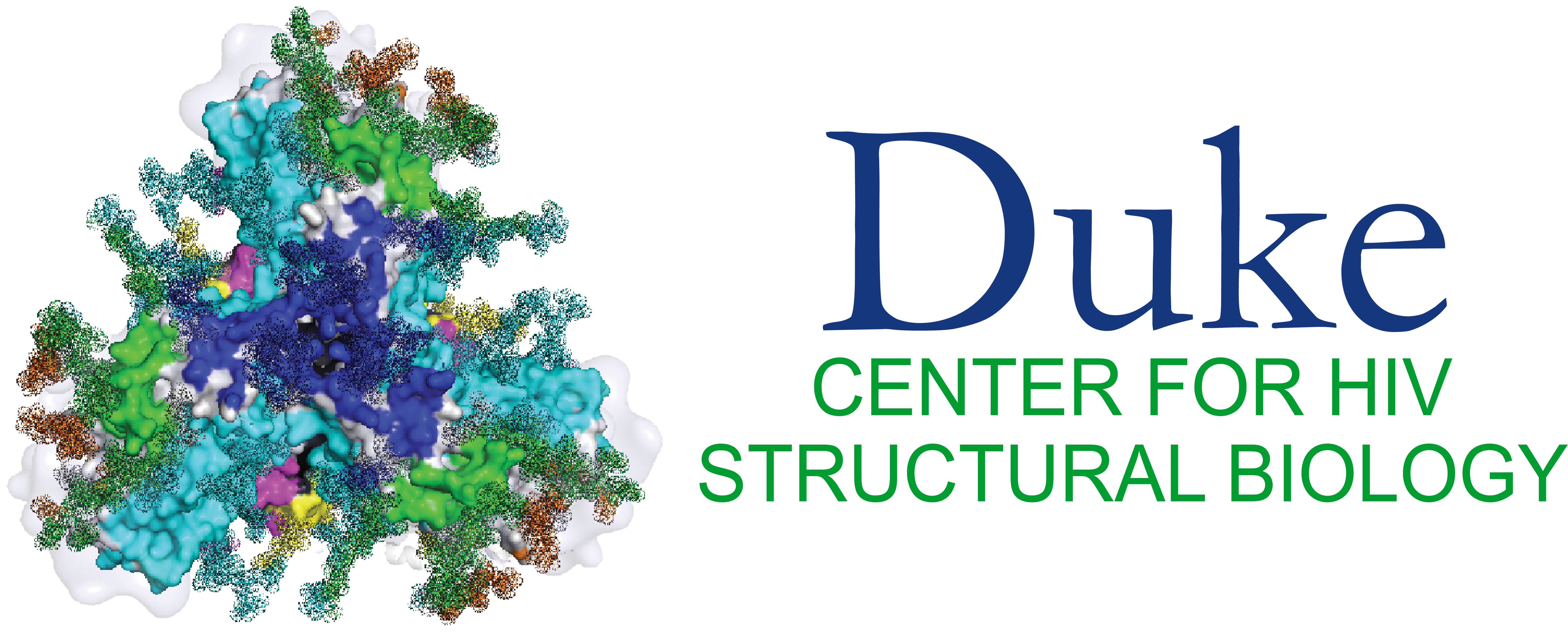Publications
Peer-reveiwed Papers
Liu Q, Parsons RJ, Wiehe K, Edwards RJ, Saunders KO, Zhang P, Miao H, Tilahun K, Jones J, Chen Y, Hora B, Williams WB, Easterhoff D, Huang X, Janowska K, Mansouri K, Haynes BF, Acharya P, Lusso P. Acquisition of quaternary trimer interaction as a key step in the lineage maturation of a broad and potent HIV-1 neutralizing antibody. Structure. 2025 May 23:S0969-2126(25)00176-5. doi: 10.1016/j.str.2025.04.020. Epub ahead of print. PMID: 40412376.
Katte RH, Xu W, Han Y, Hong X, Lu M. (2025) Inter-protomer opening cooperativity of envelope trimers positively correlates with HIV-1 entry stoichiometry. mBio. 2025 Apr 9;16(4):e0275424. doi: 10.1128/mbio.02754-24. Epub 2025 Feb 25. PMID: 39998217; PMCID: PMC11980385.https://journals.asm.org/doi/10.1128/mbio.02754-24
Watson, A. J. I., & Bartesaghi, A. (2024). Advances in cryo-ET data processing: meeting the demands of visual proteomics. Current Opinion in Structural Biology, 87, 102861. https://doi.org/10.1016/j.sbi.2024.102861
Vukovich, M. J., Shiakolas, A. R., Lindenberger, J., Richardson, R. A., Bass, L. E., Barr, M., Liu, Y., Go, E. P., Park, C. S., May, A. J., Sammour, S., Kambarami, C., Huang, X., Janowska, K., Edwards, R. J., Mansouri, K., Spence, T. N., Abu-Shmais, A. A., Manamela, N. P., Georgiev, I. S. (2024). Isolation and characterization of IgG3 glycan-targeting antibodies with exceptional cross-reactivity for diverse viral families. PLoS Pathogens, 20(9), e1012499. https://doi.org/10.1371/journal.ppat.1012499
Saunders, K. O., Counts, J., Thakur, B., Stalls, V., Edwards, R., Manne, K., Lu, X., Mansouri, K., Chen, Y., Parks, R., Barr, M., Sutherland, L., Bal, J., Havill, N., Chen, H., Machiele, E., Jamieson, N., Hora, B., Kopp, M., . . . Haynes, B. F. (2024). Vaccine induction of CD4-mimicking HIV-1 broadly neutralizing antibody precursors in macaques. Cell, 187(1), 79-94.e24. https://doi.org/10.1016/j.cell.2023.12.002
Parthasarathy, D., Pothula, K. R., Ratnapriya, S., Cervera Benet, H., Parsons, R., Huang, X., Sammour, S., Janowska, K., Harris, M., Sodroski, J., Acharya, P., & Herschhorn, A. (2024). Conformational flexibility of HIV-1 envelope glycoproteins modulates transmitted/founder sensitivity to broadly neutralizing antibodies. Nat Commun, 15(1), 7334. https://doi.org/10.1038/s41467-024-51656-4
López, C. A., Alam, S. M., Derdeyn, C. A., Haynes, B. F., & Gnanakaran, S. (2024). Influence of membrane on the antigen presentation of the HIV-1 envelope membrane proximal external region (MPER). Current Opinion in Structural Biology, 88, 102897. https://doi.org/https://doi.org/10.1016/j.sbi.2024.102897
Huang, Q., Zhou, Y., Liu, H. F., & Bartesaghi, A. (2023). Multiple-image super-resolution of cryo-electron micrographs based on deep internal learning. Biol Imaging, 3, e3. https://doi.org/10.1017/S2633903X2300003X
Bennett, A. L., Edwards, R., Kosheleva, I., Saunders, C., Bililign, Y., Williams, A., Bubphamala, P., Manosouri, K., Anasti, K., Saunders, K. O., Alam, S. M., Haynes, B. F., Acharya, P., & Henderson, R. (2024). Microsecond dynamics control the HIV-1 Envelope conformation. Sci Adv, 10(5), eadj0396. https://doi.org/10.1126/sciadv.adj0396
Ao, Y., Grover, J. R., Gifford, L., Han, Y., Zhong, G., Katte, R., Li, W., Bhattacharjee, R., Zhang, B., Sauve, S., Qin, W., Ghimire, D., Haque, M. A., Arthos, J., Moradi, M., Mothes, W., Lemke, E. A., Kwong, P. D., Melikyan, G. B., & Lu, M. (2024). Bioorthogonal click labeling of an amber-free HIV-1 provirus for in-virus single molecule imaging. Cell Chem Biol, 31(3), 487-501.e487. https://doi.org/10.1016/j.chembiol.2023.12.017
Williams, W. B., Alam, S. M., Ofek, G., Erdmann, N., Montefiori, D. C., Seaman, M. S., Wagh, K., Korber, B., Edwards, R. J., Mansouri, K., Eaton, A., Cain, D. W., Martin, M., Hwang, J., Arus-Altuz, A., Lu, X., Cai, F., Jamieson, N., Parks, R., . . . Haynes, B. F. (2024). Vaccine induction of heterologous HIV-1-neutralizing antibody B cell lineages in humans. Cell, 187(12), 2919-2934.e2920. https://doi.org/10.1016/j.cell.2024.04.033
Weber, N., Hinks, B., Jensen, J., Lidahl, T., & Mendonça, L. (2023). Sample Preparation for In Situ Cryotomography of Mammalian Cells. J Vis Exp(202). https://doi.org/10.3791/65697
May, A. J., Pothula, K. R., Janowska, K., & Acharya, P. (2023). Structures of Langya Virus Fusion Protein Ectodomain in Pre- and Postfusion Conformation. Journal of Virology, 97(6), e0043323. https://doi.org/10.1128/jvi.00433-23
Liu, H. F., Zhou, Y., Huang, Q., Piland, J., Jin, W., Mandel, J., Du, X., Martin, J., & Bartesaghi, A. (2023). nextPYP: a comprehensive and scalable platform for characterizing protein variability in situ using single-particle cryo-electron tomography. Nat Methods. https://doi.org/10.1038/s41592-023-02045-0
Huang, Q., Zhou, Y., & Bartesaghi, A. (2024). MiLoPYP: self-supervised molecular pattern mining and particle localization in situ. Nature Methods. https://doi.org/10.1038/s41592-024-02403-6
Henderson, R., Zhou, Y., Stalls, V., Wiehe, K., Saunders, K. O., Wagh, K., Anasti, K., Barr, M., Parks, R., Alam, S. M., Korber, B., Haynes, B. F., Bartesaghi, A., & Acharya, P. (2023). Structural basis for breadth development in the HIV-1 V3-glycan targeting DH270 antibody clonal lineage. Nat Commun, 14(1), 2782. https://doi.org/10.1038/s41467-023-38108-1
Reviews
Dutta, M., & Acharya, P. (2024). Cryo-electron microscopy in the study of virus entry and infection [Review]. Frontiers in Molecular Biosciences, 11. https://doi.org/10.3389/fmolb.2024.1429180
Pre-publications
Harry M Williams, Wyatt A Curtis, Michal Haubner, Jakub Hruby, Marcel Drabbels, Ulrich J Lorenz. Overcoming Preferred Orientation in Cryo-EM With Ultrasonic Excitation During Vitrification. bioRxiv 2025.09.14.676144; doi: https://doi.org/10.1101/2025.09.14.676144
Jamieson, P. J., Shen, X., Abu-Shmais, A. A., Wasdin, P. T., Janowska, K., Edwards, R. J., Scapellato, G., Richardson, S. I., Manamela, N. P., Liu, S., Barr, M., Gillespie, R. A., Mimms, J., Suryadevara, N., Sornberger, T. A., Zost, S., Parks, R., Flaherty, S., Janke, A. K., . . . Georgiev, I. S. (2025). Glycan-reactive antibodies isolated from human HIV-1 vaccine trial participants show broad pathogen cross-reactivity. bioRxiv, 2025.2001.2017.633475. https://doi.org/10.1101/2025.01.17.633475
Thakur, B., Alam, J., Cronin, K., Patel, P., Anasti, K., Kane, A. P., Hossain, A., Do, H., Mansouri, K., Spence, T. N., Edwards, R. J., Janowska, K., Lella, M., Cook, A., Saunders, K., Gnanakaran, S., Haynes, B. F., Acharya, P., & Alam, S. M. (2024). Anti-HIV-1 B cell antigen receptor signaling and structure. bioRxiv, 2024.2011.2015.623645. https://doi.org/10.1101/2024.11.15.623645
Editorials (affiliated PIs)
